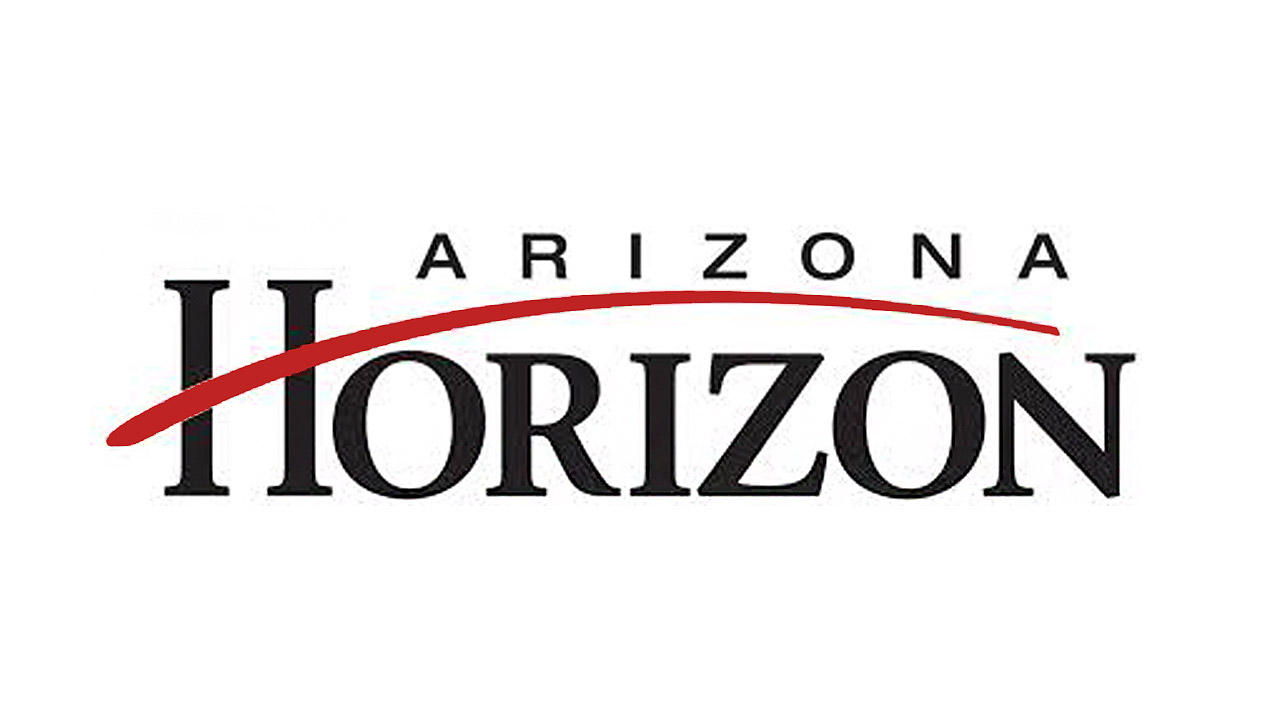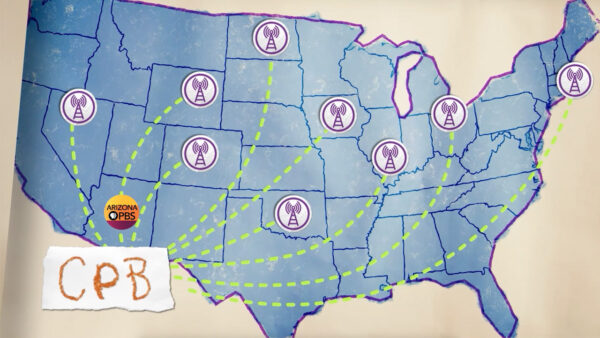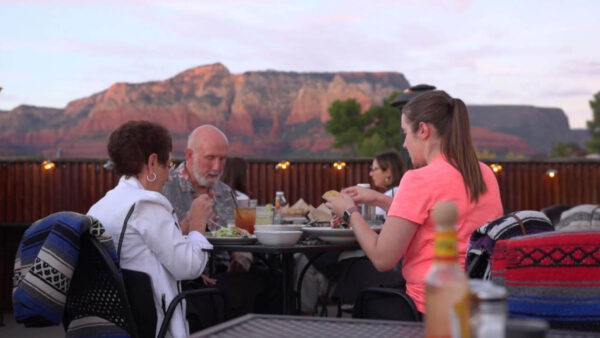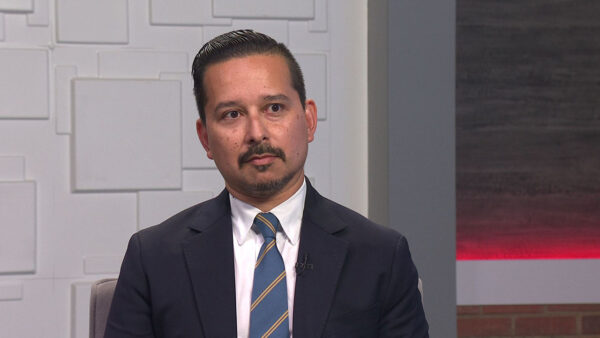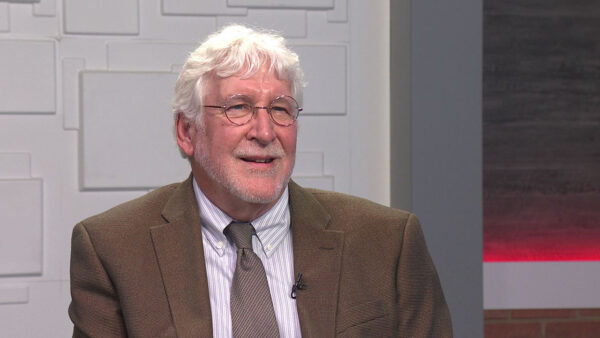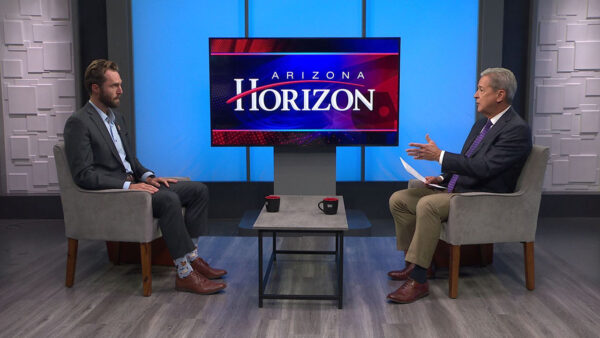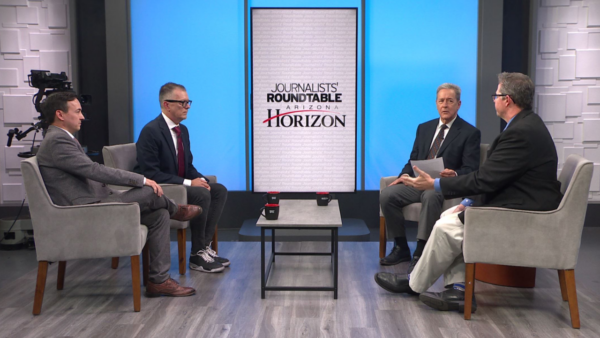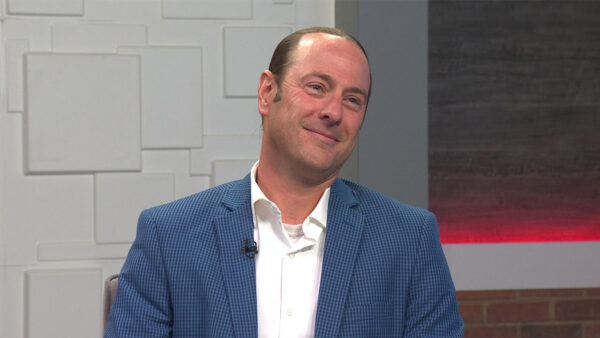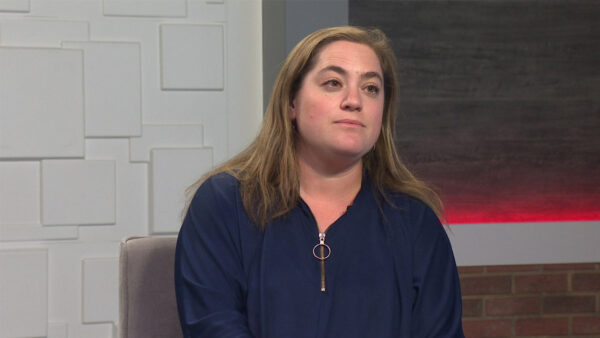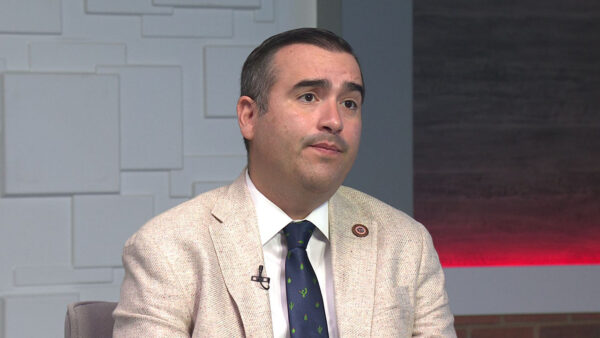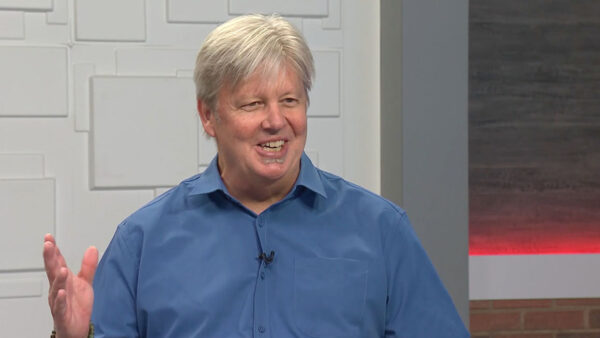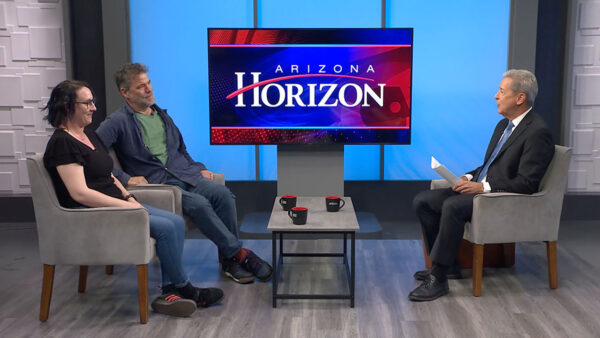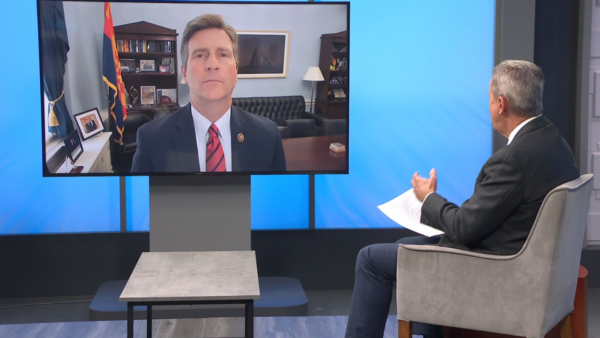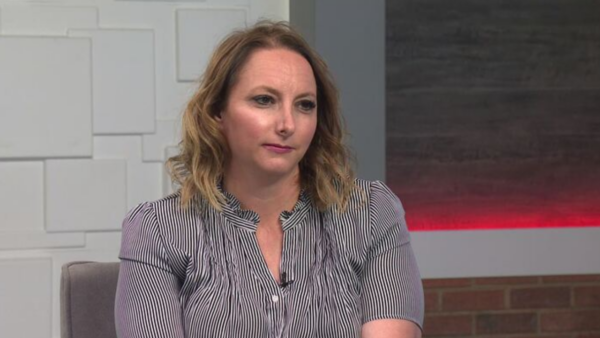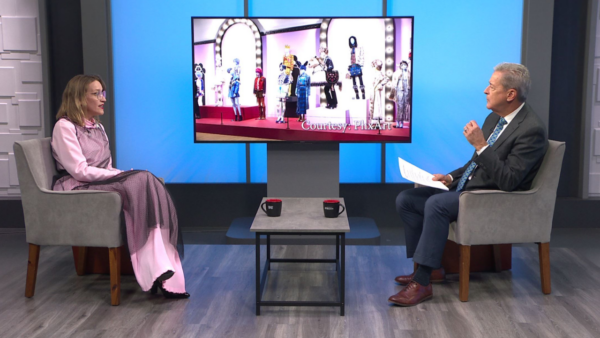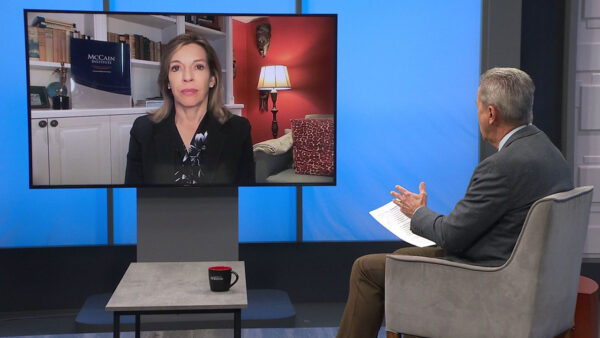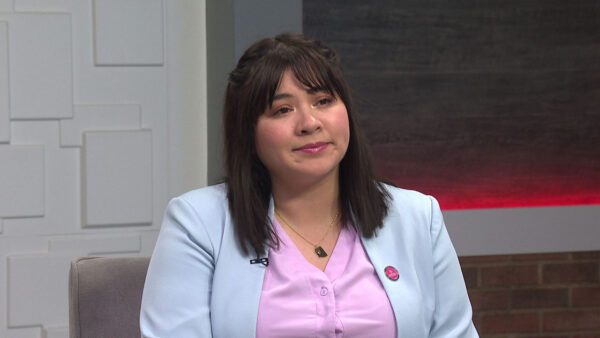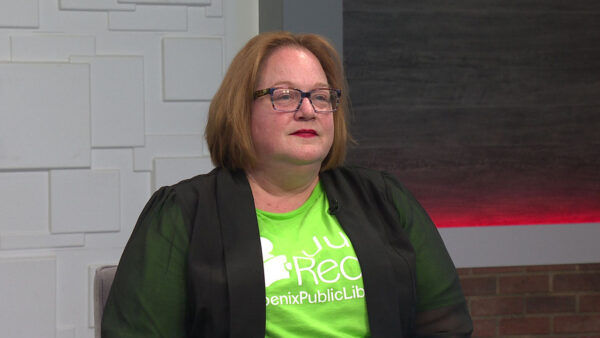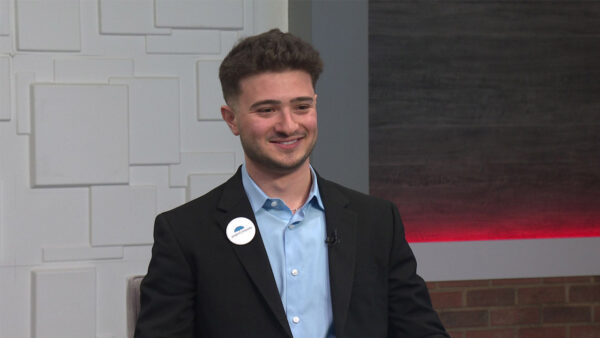Construction of the METRO light rail project is well underway. The bridge over Town Lake Bridge is almost completed and the Light Rail trains are currently being manufactured in Japan. Valley Metro CEO Rick Simonetta, appears on HORIZON to give us an update.
Michael Grant:
Tonight on "Horizon," arguments regarding funding issues for Arizona English language learners are being heard by judges at the 9th U.S. circuit court of appeals. We'll have a report from San Francisco. Plus a conversation with the former ambassador to Iraq about the current situation in that country. And are you hoping for alternative modes of transportation around the valley? We'll have an update on construction of the metro light rail project. Those stories next on "Horizon".
Announcer:
Horizon is made possible by contributions by the friends of 8 members of your Arizona PBS station. Thank you.
Michael Grant:
Good evening. Welcome to "Horizon." I'm Michael Grant. The issue of teaching English to Arizona students who speak Spanish was the focus of arguments today at the 9th U.S. circuit court of appeals in San Francisco. The case began in 1992, when parents in Nogales sued, saying their children were not learning English in school. A federal judge eventually ruled that the state was not providing sufficient money to teach English, ordered the state to come up with a better plan. The Governor allowed the legislature's most recent funding plan to become law without her signature-that after the state was fined millions for a failed previous plan. In April of this year, a federal judge in Arizona again ruled the funding in the latest plan-inadequate. Arizona's top school official, State Superintendent of Public Instruction Tom Horne appealed that ruling to a three-judge federal panel hoping they would quash that order. In San Francisco covering the case today is Howie Fischer, chief correspondent of Capitol Media Services. Howie,
thanks for joining us.
Howard Fischer:
Well, I got to ride a real trolley system here.
Michael Grant:
That's right. I understand the court peppered Tim Hogan, the attorney for the plaintiffs in Nogales Arizona Center for Law in the public interest with a lot of questions about whether or not the judge issued the right kind of ruling. Is that basically it?
Howard Fischer:
The real question I think for the court is: does money matter? As you pointed out the case is dragging on since 1992 when the state was providing a $150 per student. The legislature, after the court ruling, they raised it to 350. The federal judge said: No, you're not listening to me. I want a cost study. I want to find out what it costs to do it right and then fund it. The legislature did a cost study and didn't like the numbers that came back that were somewhere between 700 to $2,500 a student. Earlier this year they adopted $432 per student with an option for schools to follow a procedure to get more money. What essentially Tim Hogan is saying: you are still not listening. You have not done the cost study. There's no evidence you have done it statewide. He obviously wants the judge's ruling from Tucson to stay. What Tom Horne is saying is look this case started with students in Nogales and we can prove that students in Nogales, they are doing better and we shouldn't have to change the entire state funding system anymore. Clearly Eric Bistro who is Horne's attorney is saying we did blow off the cost study and never appealed the ruling and we think you shouldn't hold us in contempt and, more to the point, the $22 million in fines that the judge levied for the state dragging its feet should go away.
Michael Grant:
Interesting argument and the side of the case and the nature of the problems was alleged to be Nogales, with the Nogales School District, and they do have some data that indicates that English language learning instruction has improved there in Nogales and improved as well…so really, Judge Collins should not have moved to contempt and also the instruction to the legislature to pass more funding. At best, what he should have done back late last year was hold a hearing on what the conditions were in Nogales. Have I got this roughly correct?
Howard Fischer:
That's essentially what Tom Horne's position has been is if in fact Nogales was used as the symptomatic worst-case scenario, most number of English language learners percentage-wise, high poverty rate--if in fact they are doing better now then we've shown than you can do more without going to $700, $1,200 or $1,500 or $2,200 a student. And, so Horne is saying the federal court overstepped its bounds and going beyond the scope of the original 1992 lawsuit, which was with Nogales, and going beyond the judge's authority to force a statewide study. Again the issue there becomes assuming that the state didn't want that statewide study that was ordered in 2000, perhaps they should have appealed that point and that's Tim Hogan's point. They never appealed that point. They let it slide for whatever reason and now they want to come in and say, well, your honor, it doesn't matter.
Michael Grant:
Now under this view of what should occur, are they asking the 9th circuit court of appeals, for example, to say to the judge all right allow the legislature--the legislative plan that went into law without the Governor's signature to go in effect? You can monitor it and perhaps in two years if in fact it is not producing the right kind of results, then Mr. Hogan or some other plaintiff could come back to you and argue that it's inadequate under federal standards. Is that the kind of relief that they want?
Howard Fischer:
I think that's a piece of what they'd like. I think they're willing to accept that. To at least let the state standards, this $432 take effect and go ahead and say, you know, let's see if it works. Now again, from their best case scenario, they will say look as long as Nogales is doing well, unless you can bring another set of plaintiffs and a new lawsuit, you have no remedy. Now there are a couple of funny pieces wrapped up in this, aside from the legality of the $22 million fine. The $432 that the state came up with--says the school districts get more if they divert some of the federal money they are getting for poverty funds--which of course Hogan is saying violates federal law that you can not supplant local money. Then there is the question about the Aims--when Judge Collins ruled in December said you can't force the students who haven't gotten adequate funding for their whole career to pass and graduate-now that was stated by the 9th circuit while they are studying it. That still is in play because you could have a ruling that says English language learners don't have to pass aims until and unless they pass it statewide.
Michael Grant:
Howie, judging the ultimate outcome of cases as you well know ‘cause you cover a lot of oral arguments, it's dangerous by watching oral arguments. Were you able to get any kind of feel--as you pointed out the 9th circuit had stated certain aspects of this thing. Were you able to get, you know, much of a feel for where you thought the court was going or not?
Howard Fischer:
Well, you know, as you point out, it's very hard and I don't want to bet a lot of money on the outcomes of these things. It seems to me, on one hand you have the 9th circuit which is known to be fairly activist in terms of their willingness to say to a legislature you're not complying with the federal law. On the other hand, I think some of that reputation is kicking back on them and if in fact they believe he has exceeded his authority, they may say go back and hold an evidentiary hearing. It's a close call even the questions that Proctor Hug asked a member of the panel. He said: isn't it difficult to say we need a plan that the Governor, the legislature, and the Nogales School District and the court agrees with? Why are we trying to do it that way instead of saying you're not doing it right? Hogan's ruling is all they said to the 2000 legislature you're not doing it right. Come up with a cost study and fund it properly. Is that too far over the line? I think we'll know in a couple of weeks.
Michael Grant:
We'll wait for the written order from the 9th circuit court of appeals. Howard Fisher, thanks for joining us from 9th circuit land and have some fun in San Francisco.
Howard Fischer:
I intend to and I intend to ride the real trolleys up here not what we're building in Phoenix.
Michael Grant:
Edward Peck is a former ambassador to Iraq, former deputy director of the White House task force on terrorism. He was recently in the Valley to speak for the "Scottsdale Boomerz" and the World Affairs Council. Peck has frequently been a critic of the war in Iraq. Larry Lemmons spoke with the former ambassador.
Larry Lemmons:
You were ambassador to Iraq during the Carter administration. How would you describe the relationship then between the Sunnis and Shiite as opposed to today?
Edward Peck:
It's one of the things we've seen elsewhere. I lived in the state department environment for decades while trained experienced waited for Marshall Tito to die so Yugoslavia could flower and prosper. Saddam Hussein, vial though he may have been, served as cork which kept that place bottled into a country. There were rules, there were laws, there were restrictions, there were regulations. And everybody followed the rules. The government did not bother you unless you bothered the government, like it's supposed to be here, you know. If you go about your daily business, you don't have trouble with the government. So, in Iraq the Shiite and Sunni lived side by side, carefully and didn't bother each other because there was government in power and had no reasons to do it necessarily. I offer you a parallel. For centuries the Arabs and the Jews and the Christians lived in peace and harmony in the Middle East. It doesn't necessarily mean that I liked him or that she necessarily liked me. But they lived in peace and harmony until it becomes a struggle over power or land, and then you have trouble… anywhere.
Larry Lemmons:
You can't talk about the Middle East without talking about Palestine.
Edward Peck:
Yep. Because that is we don't like to think about that. There's many who will refuse to accept it in this country. From the perception of the people who live in the Middle East and much of the rest of the world, one of key destabilizing situations out there is the occupation of Palestine and the continued occupation of Palestine and the suppression of the Palestinian people in their own homeland. A lot of folks don't like that. And they perceive us as being largely responsible because we facilitate, finance and arm and protect Israel. So that even if tomorrow, the situation in Iraq were to disappear and all of a sudden they are all sitting around the campfire, drinking steaming mugs of cocoa and singing "kumbaya," you will have the festering horror of occupied Palestine. And unless and until you have that straightened out in the parties, you are not going to have peace and security in the Middle East.
Larry Lemmons:
How would you describe the American consciousness in the wake of 9/11? And al-Qaeda's not through. They just had another indication there was an attack planned in the subway with cyanide. We attacked Afghanistan for 9/11. Rightly or wrong we went into Iraq. So, how would you describe the American consciousness in the wake in all of this?
Edward Peck:
Americans for the most part are not really knowledgeable about the rest of the world. I think you have to admit that that's the case. Most Americans aren't really certain there's a world out there unless something bad happens. We have it all in this country. Lucky us. Truly. So, when 9/11 happened, that horror, this was perfectly simple for the government to whip up a fear and frenzy of a threat today is code mauve or perhaps it's fuchsia, you know to keep them scared. Signs on freeways-or beltways we call them on the east coast. Report any suspicious behavior. Wow. We are afraid. We are frightened and angry. We lashed out at Afghanistan and we lashed out at Iraq, which had nothing to do with it. Although as you may be aware, a significant portion of Americans still believe Iraq was involved with 9/11 and had relations with Al-Qaeda, whereas the two of them were at each other's throats. We have made an awful lot of people angry. When they tell us they hate us because of our freedoms, I always say stop, think. Why would somebody hate us because we have freedom? Where's the logic in that? Even for someone who's a marginal nut case, why would they hate us because we have freedoms? What they don't like are the policies which they think are directed against them. Called regime change. There are small groups of people, and it does not take many, who will look around for ways to make us sorry that we did it. And they have. And they can. And they are. And they will. And I hope that I am not right. I wish to be wrong. But my experiences tell me that in today's world, global village it may be, you cannot seal yourself up from the wrath of people whose perception is that you are violating everything that you say you stand for.
Larry Lemmons:
Thank you ambassador for visiting us today.
Edward Peck:
My pleasure, sir.
Michael Grant:
You probably have seen construction in several areas of the Phoenix metro area for the Valley metro light rail. The light rail will operate on two sets of tracks, with trains of up to three cars traveling in each direction. The system is scheduled to open in December of 2008. Once it is up and running, the trains will operate 18-20 hours per day, every day of the week. Currently, steel rails are already being set into the ground in some area of its path. In a moment we'll get an update on construction and some of the major milestones. First, Merry Lucero has a quick look at what's happening now.
Merry Lucero:
Construction continues for the Valley metro light-rail line. Traffic restrictions for work such as lane restrictions and relocating utilities and doing structural reinforcement are all in preparation for the 20-mile line. One major milestone-the bridge over Tempe Town Lake is nearing completion. The bridge between the existing Mill Avenue Bridge and the historic railroad bridge has 10 wide-shaped piers and 42 truss sections. It will have a fiber optic lighting system that will light up at night and provide unique visual effects. Also in Tempe and other places along the line, remains of ancient Hohokam burial sites and artifacts have been found. Archeologists are carefully uncovering the sites. The line will span from 19th Avenue, near Bethany Home Road in Phoenix to Main Street and Sycamore in Mesa. It will connect to existing public transit and other public transportation hubs. The trains are being built in Osaka, Japan. Nearly 200 people can ride on one 92-foot train car. Three trains can be hooked together. The on a median, down the center of the street.
Michael Grant:
Joining me now on how the metro light-rail is going is Rick Simonetta, the CEO of the Valley Metro. Tell me about the light thing on the Tempe Bridge.
Rick Simonetta:
Well, the Tempe Bridge is going to be one of the art features. Beneath the surface where the tracks are and where the trains will operate is a configuration, a constructional configuration that allows for us to put in a lighting system. And so the lighting system will be capable of illuminating in multi-colors and single color and, really a unique feature is that the light will follow the train across the bridge. It's a really interesting feature for an interesting place, Tempe Town Lake.
Michael Grant:
Tempe for a long time has done impressive light displays along Mill Avenue and sounds like it will fit in pretty well.
Rick Simonetta:
The Bridge is almost finished. It will be finished in about September and I think it's in December we will have a public display of the lighting feature. So, that'll be right around the holiday time, a time when Tempe really does get into a festive mood.
Michael Grant:
Percent completion at this stage?
Rick Simonetta:
We're 35% completed with construction. And of course, anyone who drives along the 20-mile alignment can see that construction is actively underway. Places like Downtown Phoenix will be finished to a large extent by the end of this calendar year. And then over the course of the next two and a half years different segments will be finished so we can have a December 2008 20-mile opening.
Michael Grant:
Downtown Phoenix has been a problem for a while. You had an unfortunate confluence with the Civic Plaza expansion going on at the same time. I think that's the reason for the 5th Avenue, 3rd Avenue, Washington diversion. Are they wrapping that aspect this fall?
Rick Simonetta:
Actually, in October they are scheduled to turn over Washington Street to the light-rail project. I think everyone remembers driving into a dip under the Phoenix Civic Plaza at the time. Well, that entire structure is being removed. And so it's because of that removal of that structure and the construction of a new roadway that will have light-rail on it that has caused the street to be down and detour to be in effect.
Michael Grant:
We saw some construction footage of the trains in Japan. Is that just because the Japanese make those particular cars or what's the story behind that?
Rick Simonetta:
It was a competitively bid project. So they were the low bid. There are no car manufacturers of any kind of rail in the United States. Anyone that wants to buy a light-rail or subway-type vehicle has to go abroad. Kinki Sharyo has a good reputation for building light-rail cars. The first car is due to arrive in December of this year. We'll start to see cars in the test track early next spring.
Michael Grant:
I think when we started these updates that was a while back we were focused on the maintenance facility. I think the primary activity focused around Sky Harbor Airport, did it not? And with the maintenance facility is that completed at this stage?
Rick Simonetta:
Well, the maintenance and storage facility is a critical part of the
Light-rail needless to say. It's on schedule and to be finished in November so when the first car arrives in December, it will be ready to receive the car. And we are out for contractors now to actually do the maintenance of the vehicles and then we'll be out for contracts to actually hire the people who will operate the trains. So everything is really on track. The first car gets here in a few months and maintenance and storage facility will be ready for it. And then, over the course of 2007 and into 2008 every month we will receive one or two new cars. As they come in, we will commission them and test them and of course put our operators through the necessary training.
Michael Grant:
Rick, I lost track. I know at one stage they were talking about some sort of people-mover or other function that would get you from point A to point B. Point A being Sky Harbor Airport and point B being the Metro System. Where are we on integrating those two?
Rick Simonetta:
Well, the idea is to connect the airport with the light-rail system at 44th street and Washington. We will have a station there. The station will be built such that when a people-mover is constructed by the airport, it will be integrated right into that station so it will be a seamless transfer from light-rail onto a people-mover. That project is not on the same schedule that we're on. And what the airport is going to do in the interim is provide free bus service. So it will be possible for someone to take the train from Mesa, Tempe or Phoenix to the 44th street station, get off the train, cross the street, get on the bus and be transported to any one of the terminals free of charge. It's not as convenient as an automated people-mover. It's still a pretty good connection and something we'll try to market.
Michael Grant:
It sounds like to me what you'll have on the side of airport buses is today I think you've got basically the terminals and the parking lots. You just scribbled down at the bottom terminals, park and parking lots and light-rail. That will take you out to 44th street?
Rick Simonetta:
44th Street. A lot of details are being worked out between Metro and the Airport.
Michael Grant:
What about the archeological phenomenon? We saw some digging and scratching and those kinds of things going on in the video. Have many sites been encountered?
Rick Simonetta:
Well, there have been two major sites. One at Tempe at the Sun Devil Stadium on Stadium Drive. That was shown on video earlier. That's still a pretty active site. The archeologists are working and they're not impeding on the construction. The contractor is working in other areas. Once the archeological work is done, then they will go back to the area. The other location is Phoenix on Washington Street, where there has been a historic finding of artifacts. That was not a surprise to us. It was a bit of a surprise to find such a large archeological site at Stadium Drive in Tempe.
Michael Grant:
I know there were a lot of business disruptions early on and a number of programs trying to help businesses out. How is that process going?
Rick Simonetta:
That's an active and important process. We have probably three thousand businesses located along the 20-mile alignment. We want to keep them thriving during construction. Once light-rail is up and operating, they will thrive. We have a number of programs in effect where we provide business assistance. We work with the cities to actually provide loan assistance for the businesses. We have community advisory boards with community stakeholders who actually work to oversee the way the contractors are doing the construction. The effort is to minimize the impact during construction, keep these guys in business and really let them thrive once light-rail is up and carrying people to their establishment.
Michael Grant:
We will keep our fingers crossed for florishment. Rick thanks for joining us.
Rick Simonetta:
It's a pleasure, Mike.
Announcer:
A Maricopa County Superior Court judge makes another ruling on the human smuggling conspiracy cases. This time four defendants are set free until their trial date. We'll talk with one of defendant's attorney. And a look at butterflies and how they can help us see the world. That's Wednesday at 7:00 p.m. on "Horizon."
Michael Grant:
For transcripts of "Horizon" and to find out about more about upcoming topics on the program you can visit the website. And next following "Horizon," stay tuned for "Arizona Stories". Among tonight's stories: Sun City, Governor W.P. Hunt, Falcon Field and the Rosson House. "Arizona Stories," tales of our unique people, places and history airs every Tuesday at 7:30 p.m. Thank you very much for joining us on this Tuesday edition of "Horizon." I'm Michael Grant. Have a great one. Good night.
Edward Peck:Former ambassador to Iraq and former deputy director of the White House task force on terrorism;Rick Simonetta:CEO, Valley Metro;
